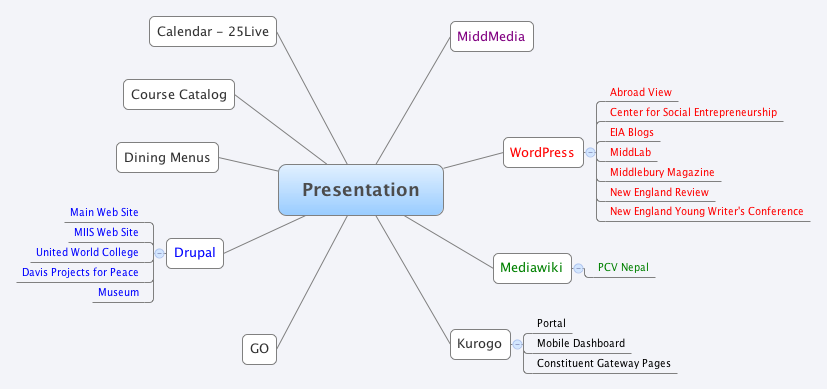The Middlebury community has a strong culture of creating and sharing, whether it is a story on the homepage, an exhibition at the museum or a project in MiddLab. These sites balance visual appeal to keep our visitors engaged with what we are doing, with organization that makes the the abundance of information easy to find. Aligned with these goals is integration of social media elements that allow internal and external visitors provide comments and additional information and we push content to audiences in Twitter and Facebook.
We have been tracking activity across our web sites since January, giving us some good information on how our web sites are being used. Here are some high level stats based on data collected from January 1 – June 30 2012 across over 550,000 pages.
Visits: 3,933,170
Unique Visitors: 2,236,190
Page Views: 12,227,234
We are averaging over 3 pages per visit, with the average visit lasting over 3 minutes.
No surprise that the most visited page in our web presence is the homepage, receiving over 2,000,000 visits during the 6 month period. Placement can change based on the time of year, but the other top pages include academics, athletics, the portal pages, the online directory, and our login page.
To support these types of web sites and pages we have a number of platforms that we use.
Three main presentation platforms
Drupal – an application framework that we use to build CMS applications for the Midd and MIIS main sites, Davis United World College Scholars, Davis Projects for Peace and the Museum. Content is a mix of static (text, images and media stay the same until someone changes it) and dynamic (feeds of information update from other sources, like 25Live and blog rss feeds).
WordPress – self-service and flexible platform, supporting over one thousand sites. Provide the ability of the site owner to change the look and feel through a number of themes, and turn functionality on and off as needed. WP allows for the display of dynamic and static content. A number of plugins allow for pushing content to social media platforms, as well as pulling in content from resources like Google Maps.
Kurogo – modular framework for adding condensed views of content throughout our web presence, currently drives the mobile dashboard, the portal and the constituent gateways. The service contains very little content, almost all of the text, images and media are pulled from other sources.
There are other platforms that either support the presentation of web content, or provide a presentation for information that lives in another system.
Calendar: 25Live – generates the main calendar view, as well as spuds for individual departments. Provides a presentation layer for information in R25.
Course Catalog – Presentation layer of course information stored in Banner. Also provides course listings for academic departments and faculty.
Dining Menus – Presentation layer for our menu system
GO – a shortcut service and a way to keep persistent urls as web sites change. The addition of QR codes for every shortcut has made this a valuable tool for our print media.
Mediawiki – rarely used to build a web site because it is not easy for a wiki owner to provide an appealing look and feel, but the tracking and discussion features are useful for a site that requires a lot of collaborative editing for all content. This is the same platform that runs Wikipedia.
Middmedia – an interface to media storage, it provides embed code for audio and video streaming as well as direct links for download.
This post is a follow up from the Middlebury’s Web Presence – A Few High Level Snapshots post. Next up will be an overview of our curricular platforms.

